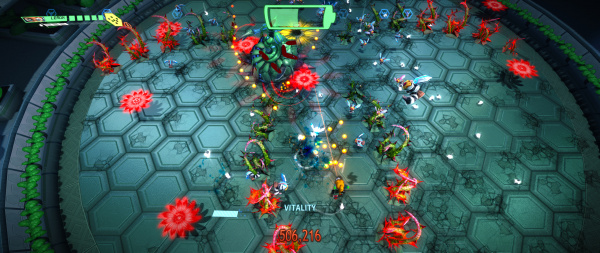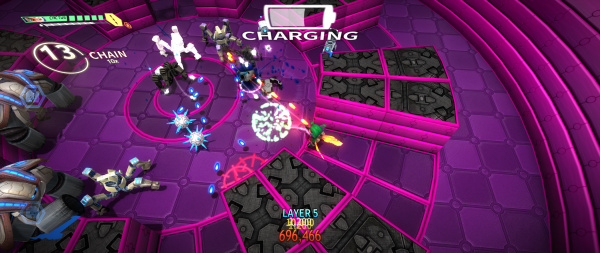Indiescovered: Assault Android Cactus

Witch Beam’s Assault Android Cactus isn’t the most unknown game, but it’s one I feel is worth highlighting. The title is a twin-stick shooter that initially gained recognition for being one of the few Early Access games that felt polished in terms of visuals and gameplay, providing a satisfying experience from day one. The now-finished game provides three modes of play: Campaign, Infinity Drive, and Daily Drive—each of which can be played both as a single-player or local co-op endeavor, and offers an assortment of characters with their own weapons and personalities.
The campaign takes players through a set of hand-designed levels, separated into several zones, each of which has a boss at the end—as a group of androids attempts to restore the core of a ship that has fallen victim to a robot uprising, but I’ve spent most of my time in-game split between the Infinity Drive and the Daily Drive. The Infinity Drive is an endless, procedurally generated self-modifying arena that provides the same set of challenges in the same order every time. The Daily Drive is a finite version of the Infinity Drive that gives players a new challenge and a new leaderboard each day. You only get one shot at each Daily Drive. Additionally, each game mode provides separate leaderboards for one, two, three, and four player play. The campaign provides separate leaderboards for each level as well, meaning that you can fight your friends for the highest score as you work your way through the story.
The most notable aspect of the game is that it plays differently than other twin stick shooters. Rather than relying on a health bar Assault Android Cactus uses a battery meter and a shield meter. Your battery meter will constantly deplete and you must collect batteries that drop from enemies at certain intervals to keep going. Your shield meter depletes when you take damage. When your shield meter runs out you are knocked out and must recover by pressing the fire button repeatedly until you are back on your feet. If you’re knocked out too much you will quickly run out of battery due to the downtime. Furthermore, when you are playing the game cooperatively everyone playing shares one battery so you have to ensure that everyone is staying on their feet in order to succeed in co-op. Getting knocked out will also cause you to lose a significant chunk of your score, which can be brutal when co-op rounds go awry.
The weapon system is also somewhat different. Each character has their own set of two weapons. One weapon can be used continuously, while the other more powerful weapon will generate heat when used and cool off while holstered. Enemies drop energy orbs that will power up both weapons once enough orbs are collected to fill the power bar. If you do not collect energy orbs quickly enough the bar will begin to deplete. If you get knocked out, you will lose all of your energy and your weapon’s power level will reset. There’s an emphasis on collecting orbs quickly and often to keep your weapon’s power level up. If you end up with low weapon power after several waves of opponents, your chances of survival are reduced significantly.
These weapons are complemented by a set of three power ups: a speed boost, a power up that freezes all enemies in place, and a power up that gives you two drones that fire in the direction you’re firing in. One drop contains all three, which cycle on a timer. Each power up has a different use, which means that collecting the right one in each situation is important. For example, if you’re surrounded you will likely want to freeze all enemies in place instead of collecting the speed boost.
The game is also home to one of my favorite game design tricks of all time. Each bullet deals one damage to the player’s shields. Instead of using a proper explosion for explosives, Assault Android Cactus’ explosives explode into a cloud of bullets. The end result of this design decision is that you can skim the edges of explosions and live. Narrowly avoiding certain death by the skin of your teeth as a bomb explodes right next to you is one of the most intense thrilling experiences I’ve had in any twin stick shooter.
Assault Android Cactus is a game that I keep coming back to. It is easy to pick up and play, the game feels exceptionally smooth, and the art style and characters give it a certain level of charm. It is—with the exception of the extra challenging Daily Drive—impeccably balanced, giving you many fair chances at succeeding before you fail. There are leaderboards on everything and fresh challenges await you every day, meaning that there is a ton of replayability. It is polished to the point that you can see your reflection in it. It is my go to when I just want to relax and tear through waves of enemies. It’s a game that does something different in a saturated genre. It’s a game that every fan of twin-stick shooters needs to own.
--
Assault Android Cactus is available on Steam and the PlayStation Store for $14.99





